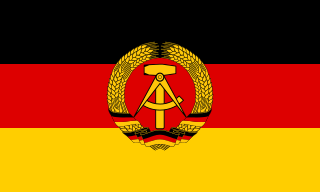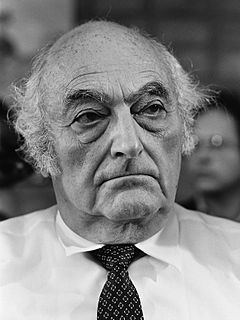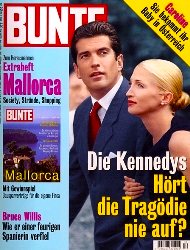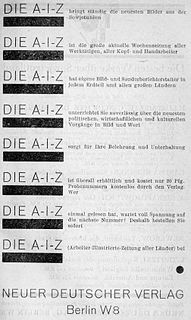
East Berlin was the de facto capital city of the German Democratic Republic from 1949 to 1990. Formally, it was the Soviet sector of Berlin, established in 1945. The American, British, and French sectors were known as West Berlin. From 13 August 1961 until 9 November 1989, East Berlin was separated from West Berlin by the Berlin Wall. The Western Allied powers did not recognize East Berlin as the GDR's capital, nor the GDR's authority to govern East Berlin. On 3 October 1990, the day Germany was officially reunified, East and West Berlin formally reunited as the city of Berlin.

East Germany, officially the German Democratic Republic, was a country that existed from its creation on 7 October 1949 until its dissolution on 3 October 1990. In these years the state was a part of the Eastern Bloc in the Cold War. Commonly described as a communist state, it described itself as a socialist "workers' and peasants' state". Its territory was administered and occupied by Soviet forces following the end of World War II—the Soviet occupation zone of the Potsdam Agreement, bounded on the east by the Oder–Neisse line. The Soviet zone surrounded West Berlin but did not include it and West Berlin remained outside the jurisdiction of the GDR. Most scholars and academics describe the GDR as a totalitarian dictatorship.

Günter Schabowski was an East German politician who served as an official of the Socialist Unity Party of Germany, the ruling party during most of the existence of the German Democratic Republic (GDR). Schabowski gained worldwide fame in November 1989 when he improvised a slightly mistaken answer to a press conference question. That raised popular expectations much more rapidly than the government planned and so massive crowds gathered the same night at the Berlin Wall, which forced its opening after 28 years. Soon afterward, the entire inner German border was opened.

Helmut Flieg or Hellmuth Fliegel was a German writer, known by his pseudonym Stefan Heym. He lived in the United States and trained at Camp Ritchie, making him one of the Ritchie Boys of World War II. In 1952, he returned to his home to the part of his native Germany which was, from 1949 to 1990, the German Democratic Republic. He published works in English and German at home and abroad, and despite longstanding criticism of the GDR remained a committed socialist. He was awarded the 1953 Heinrich Mann Prize, the 1959 National Prize of East Germany, and the 1993 Jerusalem Prize.

The Berliner Zeitung is a daily newspaper based in Berlin, Germany. It was founded in East Germany in 1945 and continued publication after reunification.
Junge Welt is a German daily newspaper, published in Berlin. The jW describes itself as a left-wing and Marxist newspaper. German authorities categorize it as a far-left medium hostile to the constitutional order.

Bunte is a German-language weekly celebrity gossip magazine published by Hubert Burda Media. The first edition was published in 1948 under the name Das Ufer. Under the leadership of Hubert Burda, Bunte developed into a modern popular magazine. In 2014, Bunte was the 11th most popular media brand in Germany, with 10.57 million monthly users. After Patricia Riekel stepped down, Robert Pölzer took over as Editor-in-Chief in July 2016.
Neues Deutschland is a left-wing German daily newspaper, headquartered in Berlin.

Rundfunk der DDR was the collective designation for radio broadcasting organized by the State Broadcasting Committee in the German Democratic Republic (GDR) until German reunification in 1990.

Arbeiter-Illustrierte-Zeitung or AIZ was a German illustrated magazine published between 1924 and March 1933 in Berlin, and afterward in Prague and finally Paris until 1938. Anti-Fascism and pro-Communism in stance, it was published by Willi Münzenberg and is best remembered for the propagandistic photomontages of John Heartfield.

Der Angriff is a discontinued German language newspaper founded in 1927 by the Berlin Gau of the Nazi Party. The last edition was published on 24 April 1945.
Jana Sorgers is a German rower who was a dominant sculler of her time, starting her career for the East German rowing team and continuing after the German reunification for the combined Germany for a few more years. Between 1986 and 1996, she won two Olympic gold medals, seven world championship titles, and nine national titles. Upon the conclusion of her successful career, she was awarded the Thomas Keller Medal by the International Rowing Federation (FISA) – the highest honour in rowing.

The Berliner Morgen-Zeitung was a daily morning newspaper in Berlin, Germany.

The Berliner Illustrirte Zeitung, often abbreviated BIZ, was a German weekly illustrated magazine published in Berlin from 1892 to 1945. It was the first mass-market German magazine and pioneered the format of the illustrated news magazine.
Guter Rat is a monthly business and consumer magazine published first in the German Democratic Republic (GDR). The magazine is one of three East German magazines which have survived German reunification, including Eulenspiegel and das Magazin.
Lucie Pflug was a senior cultural official in the German Democratic Republic.
Heinz Rein was an influential German novelist writing before and after the Second World War. He became a major figure in the "rubble literature" period, and his famous novel Berlin Finale, published in 1947, was one of the first bestsellers of the German rebuilding period.
The Wochenpost was an East German weekly. It was founded in 1953, and circulation peaked at over one million copies per issue from 1971 to the German reunification. The academic Deirdre Byrnes writes that the paper was "one of the most influential" publications in East Germany. Its highest circulation was around 1.2 million copies, making the paper the most popular weekly in East Germany. It was considered a paper for intellectuals.
Für Dich was a weekly women's magazine published in East Germany and then in Germany following the unification. It was the only publication in East Germany which specifically targeted women. Official description of the magazine in 1988 was "illustrated weekly magazine for women, with contemporary political, economic and cultural contributions." It was in circulation between 1946 and 1991.

Axel Bertram was a German commercial artist, type designer, illustrator, magazine designer and medalist. During his later decades he became, in addition, a knowledgeable and dedicated expert on calligraphy. Confident in his judgements, he also contributed articles to newspapers and magazines, though this was motivated more by a personal drive to share his enthusiasm for his ideas on design than because he aspired to any sort of career as a journalist or commentator.












